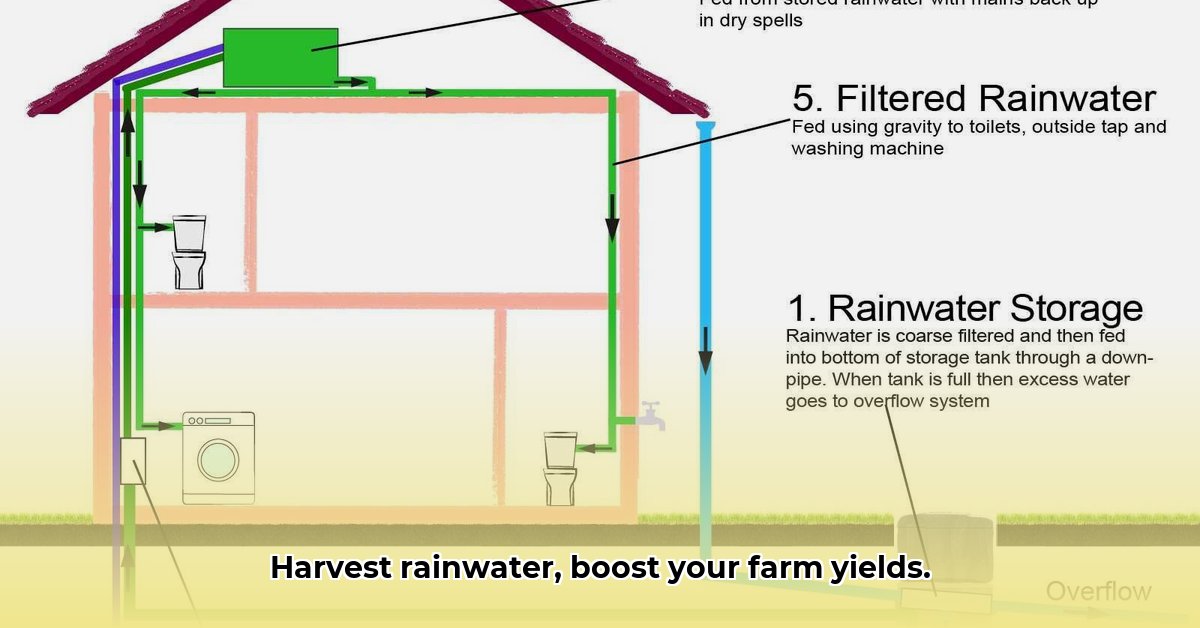Worried about water bills and unpredictable rainfall impacting your farm’s output? This guide reveals how to design a home that efficiently collects and uses rainwater, enhancing your crops and cutting costs. We’ll guide you through designing your home with your farm in mind to building a reliable rainwater harvesting system. Learn from real-world examples, discover expert tips, and grasp the long-term benefits for your farm’s success. Regardless of experience, discover how to fully use rainwater and develop a more sustainable and profitable farm. Let’s embark on building a resilient future for your farm, one raindrop at a time!
Rainwater Harvesting House Design: Boosting Farm Yields Now
Water is a critical resource, especially for farmers looking for increased yield. Imagine cutting down on your water bills and boosting your farm’s productivity simultaneously. That’s the power of designing your home to harvest rainwater to boost sustainability. It’s about creating a closed-loop system where rainfall becomes a dependable asset.
Understanding the Basics: Turning Rain into Farm Gold
Consider your roof a huge, free water collector. Rainwater harvesting is about cleverly directing this resource into storage for later use. Instead of depending solely on expensive municipal water, you’re utilizing a sustainable alternative for your irrigation needs, lowering environmental impact and building a resilient farm.
This isn’t just about saving money; it’s about being environmentally responsible by water conservation. It’s about working with nature, not against it by optimizing land use. A well-designed system reduces reliance on external water sources, builds drought resilience, and minimizes your farm’s environmental footprint.
Designing Your System: A Step-by-Step Guide
Building a successful rainwater harvesting system involves careful planning and execution. Let’s break it down into steps to increase automation:
Phase 1: The Assessment – Knowing Your Terrain
- Rainfall Analysis: Start by figuring out how much average rainfall your area typically gets. This influences the size of your system (larger rainfall means more water). Look at historical rainfall data for your location to get a more clear picture. Consider microclimates on your farm; hilly areas might receive more rainfall than valleys.
- Roof Check: Determine the size of your roof – this is your primary collection area. A larger roof equals more efficient water collection to increase the supply. Also, consider the roof material; some materials can leach chemicals into the water, requiring more robust filtration.
- Soil Survey: Understand your soil type. This helps determine how well your soil retains water and how much irrigation you’ll need. A professional soil test is beneficial to gain insights (analyzing the soil composition for irrigation needs). Analyze the soil’s infiltration rate to determine the best irrigation methods.
- Professional Advice: Seriously consider getting a professional assessment from a consultant or engineer for sustainable design practices. They provide tailored advice based on your unique conditions to help your water quality. Look for consultants specializing in agricultural water management for best results.
Phase 2: System Design – Planning Your Water Pathway
- Collection: Design your gutters and downspouts to efficiently channel rainwater from your roof to your storage tank(s). Think about preventing clogs and leaks for effective storage. Gutter guards are an excellent investment to minimize debris buildup.
- Filtration: Plan your cost-effective and efficient filtration system. Simple filtration is often sufficient for irrigation, removing leaves and larger debris. For drinking water, you’ll need a more sophisticated setup to increase water quality. Consider a multi-stage filtration system: a sediment filter followed by a carbon filter and UV sterilization for potable water.
- Storage: Choose appropriately sized tanks to maximize water potential. Consider materials — food-grade is crucial if you plan on using the water for anything beyond irrigation. Think about how much water you’ll need and how much space you have based on water usage. Explore both above-ground and underground tank options, considering space constraints and aesthetic preferences.
- Distribution: Plan how you’ll get the water to your crops safely. This could involve a simple gravity-fed system or a more complex pump-based setup based on specific needs. Drip irrigation is an efficient method for delivering water directly to plant roots, minimizing water waste.
Phase 3: Materials and Installation – Getting Your Hands Dirty (or Not)
- Material Selection: Opt for durable, non-toxic materials for your gutters, downspouts, and storage tanks. Food-grade materials are a must if you plan to use the water for anything other than irrigation, especially for sustainable agriculture. Consider UV-resistant materials for tanks exposed to direct sunlight to prolong their lifespan.
- Professional Installation: While some aspects might be DIY-friendly, professional installation is recommended to ensure proper functioning and prevent costly leaks or structural damage. They’ll also ensure the system meets local building codes that meet regulation standards. Obtain the necessary permits before starting installation to avoid legal issues.
Phase 4: Maintenance – Keeping It Running Smoothly
- Regular Cleaning: Clean your gutters and downspouts regularly to prevent blockages and maintain optimal water flow. This is essential for preventing overflow and system failures to increase water flow. Schedule gutter cleaning at least twice a year, especially after leaf fall.
- Tank Inspection: Periodically inspect your storage tanks for leaks, cracks, or any signs of damage. This ensures the quality standards of the system. Repair any damage promptly to prevent water loss and contamination.
- Filter Maintenance: Replace or clean your filters according to the manufacturer’s instructions to decrease contamination. This ensures the quality of your harvested water. Monitor filter performance regularly and adjust the cleaning/replacement schedule as needed.
Key Components: Filtration and Storage – The Heart of the System
Your filtration strategy is critical for soil amendment practices. It protects your plants from contaminants. Several options exist, from simple mesh screens to more advanced filters that remove bacteria and other impurities to ensure efficient water usage. Choose the right one based on your needs and budget effectively. Consider adding a UV sterilizer for eliminating harmful bacteria if using the water for irrigation of edible crops.
Storage solutions are equally important for agriculture practices. Select tanks based on your water needs and available space. Materials should be durable and, if intended for anything beyond irrigation, food-grade. Remember to factor in overflow protection to prevent flooding during heavy rains. Install an overflow pipe that directs excess water away from your foundation and crops.
Integrating with Your Existing Irrigation – A Seamless Transition
The adaptability of rainwater harvesting lies in its adaptability to provide sustainability. You can usually integrate your new system with your existing irrigation infrastructure. This streamlined approach maximizes efficiency and minimizes disruption to your current farming practices to increase productivity. Use a backflow preventer to protect your municipal water supply from potential contamination.
Weighing the Pros and Cons – The Big Picture
| Advantages | Disadvantages |
|---|---|
| Significantly lower water bills | Initial investment can be substantial |
| Sustainable and environmentally friendly | Relies on rainfall; yields may fluctuate in dry periods |
| Enhanced crop yields (under ideal conditions) | Potential for water contamination if not properly filtered |
| Increased property value (in some cases) | Requires regular maintenance and cleaning |
| Reduces reliance on municipal water supplies | Storage space requirements |
Tips for Maximizing Your Harvest – Extra Pointers for Success
- Maximize Collection: Use as much of your roof area as practically possible to collect the maximum amount of rainwater and save for future use. Extend your collection area by including outbuildings and sheds.
- First Flush Diverter: Consider installing a first flush diverter to increase water conservation. This critical component diverts the initial rainfall, which tends to have higher contaminant levels efficiently. This prevents pollutants from entering your storage tank.
- Regular Maintenance is Key: Consistent cleaning and inspection are crucial for the long-term health and efficiency of your system. Create a maintenance schedule and stick to it rigorously.
- Monitor Water Quality: Regularly test your harvested rainwater to ensure it meets the required standards for your intended use. This is especially important if using the water for irrigation of edible crops or for potable water.
Rainwater harvesting is more than a trend; it’s a smart, sustainable approach to farming in land management. It offers long-term benefits, saving you money and reducing your environmental impact, decreasing water consumption. The upfront investment is substantial, but the long-term savings and environmental advantages typically outweigh the costs for land management. While it isn’t the perfect solution for every farm, it represents a powerful tool for building a more resilient and sustainable agricultural future and soil management. Ongoing research continues to refine and improve rainwater harvesting techniques to conserve water. Explore government incentives and rebates to offset the initial investment costs.
How to Optimize Rainwater Harvesting Systems for Diverse Crop Yields
Key Takeaways:
- Rainwater harvesting significantly reduces reliance on external water sources, a crucial step in sustainable agriculture and farming practices.
- Proper system design, considering local rainfall, soil type, and crop needs, is paramount for success.
- Integrating rainwater harvesting with existing irrigation systems maximizes efficiency and promotes water conservation.
- Careful water quality management prevents contamination and ensures suitability for diverse crops, improving the water supply.
- Long-term planning, accounting for climate change impacts, ensures the system’s longevity and effectiveness, promoting sustainability and conservation.
- Regular monitoring of water usage helps optimize irrigation schedules and minimize water waste.
Let’s dive into how to optimize rainwater harvesting systems for diverse crop yields for efficient water
- Black and White Kitchen Backsplash: Ideas for Timeless Style - November 4, 2025
- Kitchen Backsplash Ideas: Fresh Looks to Upgrade Your Space - November 1, 2025
- Open Concept Kitchen With Island And Living Room Ideas - October 31, 2025










